Dental Care
VINAY’S DENTAL CARE
A quality treatment for your dental care needs by preserving the natural teeth as much as possible.
Vinay’s dental care clinic started by Dr labishetty vinay, who is specilized in : Conservative Dentistry, Endodontics, Implantology, Laser Dentistry, Maxillofacial Prosthodontics, Orthodontics, Paediatric Dentistry (Pedodontics). Currently working in KAMINENI HOSPITAL
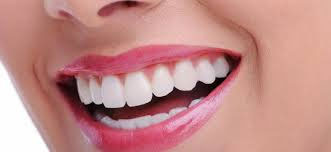
Our Treatments
DENTAL IMPLANTS
CROWN & BRIDGES
ROOT CANAL TREATMENT
Orthodontics - Fixed Braces
Dental Implants

Benifits
Dental implants have given countless patients many amazing benefits including
- Natural tooth like feeling
- Improved appearance
- Improved comfort
- Improved speech
- Eat better, enjoy more foods, better nutrition
- Convenience
- Improved self-esteem
Dental implants are a great value for your investment. Implants look much better, and feel better, than traditional removable bridges, and offer the same force for biting as bridges that are fixed in place. Implants will last your lifetime.!!!
Implant Supported Bridge What Is It?
An implant-supported bridge is similar to a regular dental bridge, but it is supported by implants and not by natural teeth. In most cases, when an implant-supported bridge is used, one implant is placed in the jawbone for each missing tooth. Then the crownsare connected to each other to form one piece.
When Is This Used?
An implant-supported bridge is used when more than one tooth is missing. It also may be used when your dentist is concerned that you might put too much pressure on individual implants that are not connected to each other. For example, clenching or grinding your teeth can put a lot of pressure on individual implants. This can increase the chances that they will loosen from the bone and fail.
An implant-supported bridge reduces the pressure on the individual implants in the bone, and spreads it across the entire bridge. If the implants will be placed next to natural teeth, the natural teeth and surrounding gums must be in good health. If you don’t have enough bone to place and support the dental implants, the supporting bone can be built up using bone augmentation or grafting before the actual implant procedure begins.
Implant Supported Bridge What Is It?
- An implant-supported denture is a type of overdenture that is supported by and attached to implants
- A regular denture rests on the gums, and is not supported by implants.
- An implant-supported denture is used when a person doesn’t have any teeth in the jaw, but has enough bone in the jaw to support implants.
- An implant-supported denture has special attachments that snap onto attachments on the implants.
- Implant-supported dentures usually are made for the lower jaw because regular dentures tend to be less stable there.
- Usually, a regular denture made to fit an upper jaw is quite stable on its own and doesn’t need the extra support offered by implants.
- However, you can receive an implant-supported denture in either the upper or lower jaw.
- You should remove an implant-supported denture daily to clean the denture and gum area.
- Just as with regular dentures, you should not sleep with the implant-supported dentures at night.
- Some people prefer to have fixed (permanent) crown and bridgework in their mouths that can’t be removed.
- Your dentist will consider your particular needs and preferences when suggesting fixed or removable options.
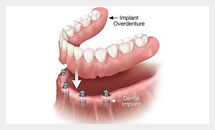
How Does It Work?
There are two types of implant-supported dentures: bar-retained and ball-retained. In both cases, the denture will be made of an acrylic base that will look like gums.Porcelain or acrylic teeth that look like natural teeth are attached to the base. Both types of dentures need at least two implants for support. Bar-retained dentures – A thin metal bar that follows the curve of your jaw is attached to two to five implants that have been placed in your jawbone. Clips or other types of attachments are fitted to the bar, the denture or both. The denture fits over the bar and is securely clipped into place by the attachments.
Ball-retained dentures (stud-attachment dentures) – Each implant in the jawbone holds a metal attachment that fits into another attachment on the denture. In most cases, the attachments on the implants are ball-shaped (“male” attachments), and they fit into sockets (“female” attachments) on the denture. In some cases, the denture holds the male attachments and the implants hold the female ones.
The Implant Process
- The implants usually are placed in the jawbone at the front of your mouth because there tends to be more bone in the front of the jaw than in the back.
- This usually is true even if teeth have been missing for some time.
- Once you lose teeth, you begin to lose bone in the area.
- Also, the front jaw doesn’t have many nerves or other structures that could interfere with the placement of implants.
- Two surgeries usually are needed. The first one places the implants in the jawbone under your gums.
- The second surgery exposes the tops of the implants.
- A one-stage procedure is now used sometimes.
- In this procedure, your dentist can place the implants and the supporting bar in one step.
- The success rate of this procedure is high
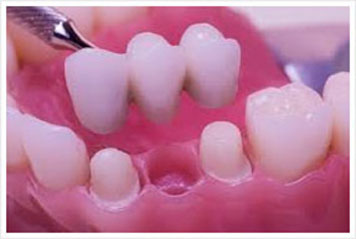
CROWN & BRIDGES
Crowns and bridges are types of Dental restoration which completely encircle and protect a tooth or implant. They are typically used when a large cavity threatens the health of a tooth. Crowns are implanted with dental cement. Dental crowns restore the Anatomy of the tooth, restore tooth functions and aesthetics. Dental Crowns can be used for replacement of both fixed teeth and missing teeth. Dental crowns or caps are available as Metal ceramic Crowns and the latest Zirconium Crowns. The life of the Zirconium crown / teeth is long lasting and permanent.
ROOT CANAL TREATMENT
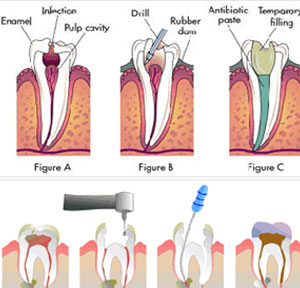
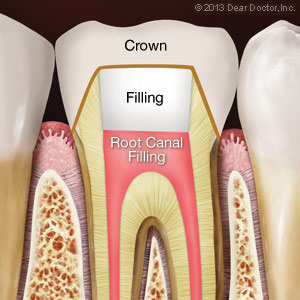
Why is the Root Canal performed?
The pulp is the living tissue of the tooth with blood supply and nerve supply. Once the dental caries (decay ) involves the pulp, the pulp gets infected causing pain. The aim of the root canal treatment is to remove the infected pulp. This is done by removing the infected pulp with files in the pulp chamber and cleaning and shaping the root canals and sealing the canal with a filling material.
THE STORY OF ROOT CANAL THERAPY
Each tooth has a soft tissue – the pulp which nourishes the tooth. Because of deep decay, injury, or gum disease, the pulp tissue in your tooth has become inflamed or infected. In any other part of your body, if a similar tissue becomes diseased, the body merely throws it off and forms new tissue. However, a tooth is a unique and different. Because the infected soft tissue (pulp) within the tooth is totally encased within hard tissue, it is the role of the dentist to remove the soft tissue located in the root canals, cleanse the area, and finally fill the canals with a special material so that bacteria cannot re-enter the tooth to cause another infection. When the endodontic treatment is complete, the tooth is by no means “dead”. It receives quite adequate support from the surrounding tissues and may be expected to last as long as any other natural tooth. Nothing is as good as a natural tooth! And sometimes your natural tooth may need endodontic (root canal) treatment for it to remain a healthy part of your mouth. Most patients report that having endodontic (root canal) treatment today is as unremarkable as having a cavity filled. Expert endodontics services are carried out in our clinic. They have a wide experience in this regard.
Orthodontics – Fixed Braces
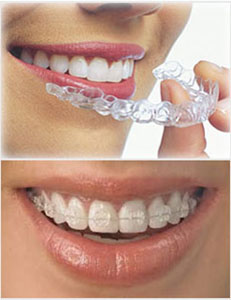
The Starting Point
Most courses of orthodontic treatment begin with a referral from a general dentist to a specialist. Depending on what treatment is needed, most patients are seen by a specialist in a local practice or by a consultant in hospital. Some patients are treated by dentists with extra training and experience to treat the milder cases. These are some of the most common reasons for a referral:
- Protruding upper front teeth – one of the most common dental problems
- Crowding – a narrow jaw may mean there is not enough room for your teeth, resulting in crowding. Conversely, some patients have significant gaps between their teeth.
- Asymmetry – particularly when the centre lines of the upper and lower front teeth do not match, perhaps because the teeth have drifted or the position of the jaw has shifted.
- A deep bite – when your upper teeth cover the lower teeth too much
- A reverse bite – when your upper teeth bite inside the lower teeth
- An open bite – when your front teeth remain apart when your back teeth meet; the tongue is often still visible between the upper and lower front teeth.
Braces are almost always needed. Those which are used most often are:
- A Fixed Brace – This is the most common type of brace today, often known as “train tracks”. Brackets are glued onto the teeth and linked by wires. Small elastic hoops are often used to hold the wire in position. The wires exert gentle pressure to move the teeth into a new position. The brackets can be metal, ceramic or even gold and the elastic loops come in many colours.
- A Removable Brace – This is sometimes used for correcting a simple problem, such as moving a single tooth or expanding the dental arch. It has a plastic baseplate with wires and springs attached. Removable braces need to be worn all the time except for cleaning or sport.
- Functional Appliances – These are used to harness the growth of the jaws and improve way the upper and lower teeth meet. There are several designs all of which fit on to both the upper and lower teeth and hold the lower jaw forward. They are mostly removable but should be worn as near to full-time as possible.
- Retainers – At the end of treatment, all patients should wear retainers to hold their teeth in the new position. These can be removable or fixed and are an important part of treatment.
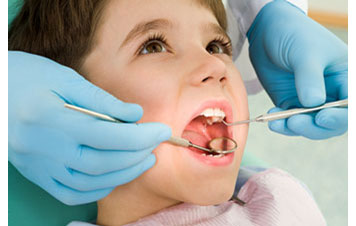
Pediatric Dentistry – Children Dentistry
Periodontics Gum Therapy
A Beautiful Smile Begins with Healthy Gums
Gum Diseases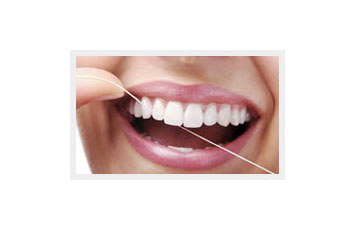
Did you know that more than 75% of all adults in India have gum disease?
- Many people have gum disease and are not even aware they have this problem. Did you know that gum disease is the #1 reason adults lose their teeth
- Gum disease is a “silent” disease-until your teeth become loose and fall out
- many people do not know they have it and how seriously they do.
Did you know that HIV (the virus that causes AIDS) can be passed by kissing between two people who have advanced gum disease?
Wondering if you have gum disease????
“You have any one of theses symptoms then, do visit us soon to save your gums”
- Do your gums bleed when you brush, floss or use a toothpick?
- Are your gums red, swollen and painful?
- Do you have pus coming from between your gums and teeth if you push on your gums?
- Are your gums pulling away from your teeth?
- Has there been a change in the way your teeth come together when you bite or chew on food?
- Do your teeth look longer because of receding gums?
- Are your gums pulling away from your teeth?
- Has there been a change in the way your teeth come together when you bite or chew on food?
- Do your teeth look longer because of receding gums?
- Are your teeth loose?
- Do you have bad breath?
- If you wear a partial denture does it still fit the same?
- If any of these statements are true then you may have a problem with your gums.You should visit your dentist and get an evaluation and schedule an appointment. You may need more than just a routine cleaning for your teeth to get your gums healthy again.
- A thorough evaluation of your gums and your overall dental health includes a comprehensive examination, a complete set of x-rays, and periodontal probing.If there is bone loss and deep pocketing you may need non-surgical periodontal or surgical periodontal care.
- Did you know that gum diseases are treatable!!!!!!
Treatment of Periodontal Disease
Periodontal disease is completely treatable. Once periodontal disease has been detected and diagnosed, advanced procedures individually tailored to your stage of gum disease are performed: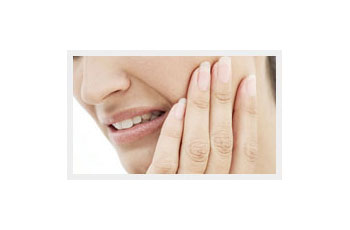
- Scaling and Root Planning
- Non Surgical Laser Treatment
- Flap Surgery
- local Drug Delivery
- Bone Grafting
Sensitivity of teeth can be defined as a dental pain, sharp in character and of a short duration, due to exposed dentin surfaces of the teeth in response to stimuli. The main causes of Sensitivity in teeth are receding gums, periodontal disease and Dental bleaching. One of the protocols developed by our Clinic / Hospital is to create awareness through education for all their patients, which is why you will notice that Doctors counsel the patients first and patiently answer all their queries. In this case, sensitivity apart from being tackled with treatment like laser de-sensitization, there is a need to take the patient through counseling which addresses issues like lifestyle management, dos and don’ts, prevention, diet advise and home treatment techniques.
Dental Scaling / Prophylaxis / Cleaning
Taking care of your Teeth and mouth is as important as taking care of the rest of your body, besides your mouth is an integral part of your body and requires equal attention. Gaining awareness on various aspects of Oral Health with regard to Dental Prophylaxis / Cleaning is therefore of utmost importance to lead a healthy life and should be made a priority too. Dental Prophylaxis or Scaling or cleaning is generally the term used by dentists for cleaning the teeth. The procedure for Dental Cleaning / Scaling of teeth is now routinely recommended by Dentists nowadays as the best way to maintain good Dental health. The reason is that small particles of food we eat get lodged in the gaps between the teeth and between the teeth and the gums and tend to remain there in spite of brushing your teeth. Over a period of time, these particles get hardened in a process called calcification. Dentists use special instruments like ultrasound devices to dislodge these particles during the process of scaling / cleaning of your teeth, which results in a clean mouth environment.
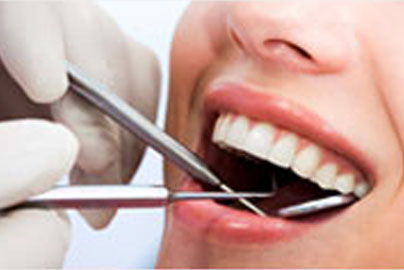
Staining / Discoloration / Change
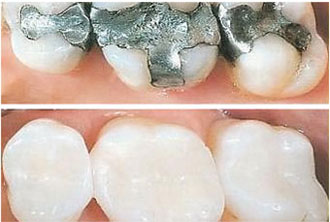
Dental Fillings / Restoration
Tooth Jewellery
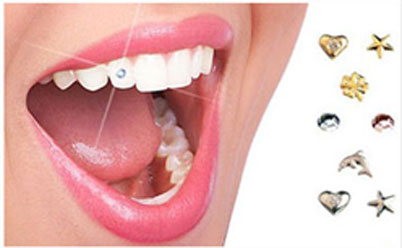
Smile Makeover
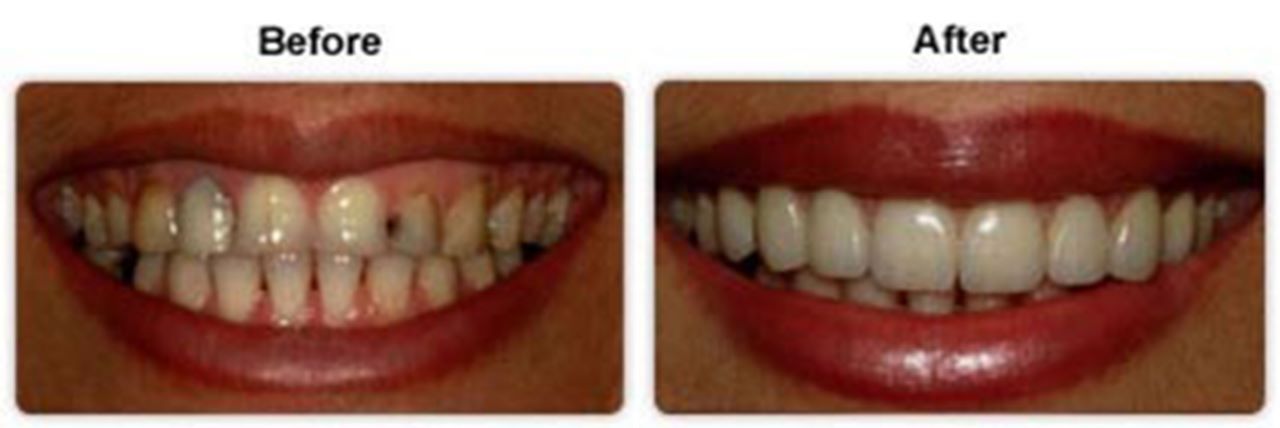
Beautiful Smiles Make the Difference
Smile makeover patients at our practice love their new smiles and find themselves smiling a lot more after treatment. Your smile is one of the first things people notice about you. A smile makeover is a cosmetic dentistry treatment that will provide you with a beautiful smile. If you have a beautiful smile, natural-looking smile, you will smile more, project self-confidence, be more positive in all aspects of life. Whatever concerns you have about the size, shape, placement, or color of your teeth, smile makeovers can fix almost any problem you present: gaps, chips, stains, discoloration, missing teeth, crooked teeth, short teeth, oversized teeth, slanting teeth, misaligned teeth, tooth grinding, gummy smiles, receding gums, unnatural or ageing dental work, and old silver fillings can all be corrected with our state-of-the-art, expert procedures. Patients come to our clinic from far distances to take advantage of the experience and artistic expertise offered by both dentists in our practice. The first step in a smile makeover is the examination appointment. A smile makeover will improve the look of your smile, as well as restore any dental problems that you have, adjust your bite, and reset the muscles in your jaw so that you will look good and feel great.
Preventive Care Dentistry
‘Prevention is better than cure’ goes the saying. One would always prefer to go by the saying or would atleast be adviced to go by the saying when it comes to ‘cure’ in dentistry. Odontophobia is one of the most commonest problems faced in dentistry. There is alot of positive and feel good attitude that can be experienced by taking up a preventive measure to avoid diseases of the teeth or gum. Amongst the various specialities in dentistry, Preventive dentistry is one of the most productive side of dentistry. Of course the productive side of delivering healthier teeth and gums. Preventive Dentistry is that branch of dentistry that aims at providing the care that is needed to keep the gums and the teeth healthy. It helps in keeping the oral cavity healthy thereby preventing the occurance of bad breath, cavities, gum diseases or other oral diseases. The first tooth develops at the age of 6 months. Prior to the development of milk tooth, care has to be taken to maintain the oral cavity especially of the gums in good health. Wet cotton swabs can be used to clean the baby’s gum pads after drinking milk. Care must also be taken to keep the lips and areas surrounding the mouth in a clean state. Once the child develops milk tooth, care must be taken to maintain the health of the milk tooth. Rampant caries is very common in milk tooth. The child must have his brushing habits started with mildly fluoridated toothpaste. Fluoridated toothpaste along with proper brushing techniques is required to help prevent cavity formation in the teeth. In case of permanent tooth, fluoride application will be required which will help strengthen the enamel and provide a shield to prevent attack by bacteria. Not only in preventing cavities but also in aligning the tooth to proper position in the oral cavity, preventive dentistry comes into play. Also Preventive dental measures to keep the teeth and gums healthy :
- Brush your teeth twice a day with a fluoridated toothpaste.
- Replace the toothbrush once in every three months.
- Rinse your mouth after having sweets and other sticky food.
- Use other dental aids like dental floss, interdental brush, mouthwash etc.
- Eat nutritious and a well balanced diet. Include a lot of Vitamin B and Citrus fruit in your diet.
- Visit your dentist once in every six months.
